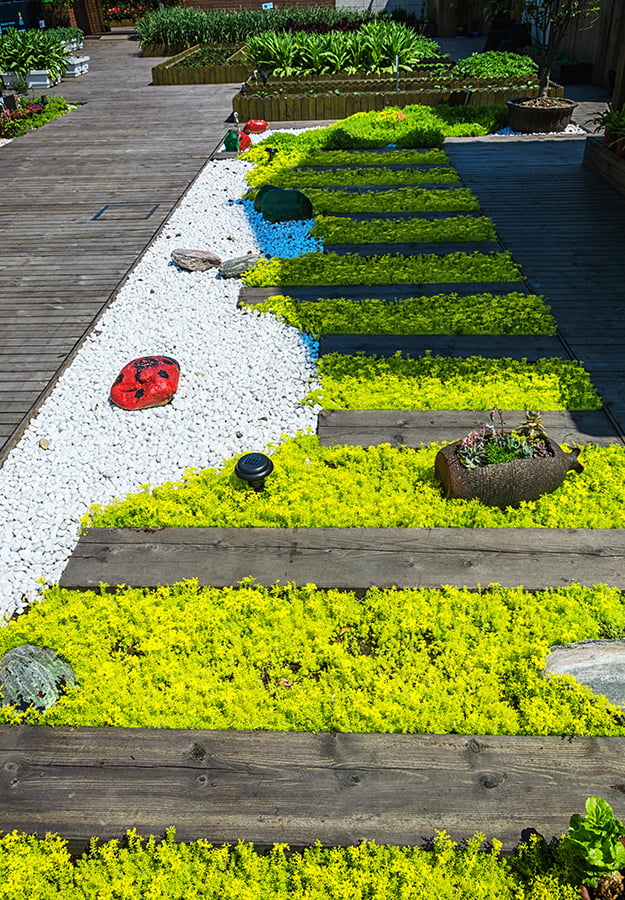Some water-efficient irrigation techniques for xeriscaping include drip irrigation, mulching, and using native plants that are adapted to local climate conditions.
Xeriscaping is a great way to save water in your garden. It involves using plants that are adapted to the climate and soil conditions of your area, as well as efficient irrigation techniques.
In this blog post, we’ll discuss some of the best water-efficient irrigation techniques for xeriscaping, so you can keep your garden looking beautiful while still conserving water. Read on to learn more!
Look Inside:
Drip Irrigation

This method of irrigation works by slowly releasing small amounts of water through a network of pipes, hoses, and emitters. The emitters are placed near the base of each plant and deliver precise amounts of water directly to the roots.
This helps reduce evaporation and runoff, making it an ideal choice for areas with limited access to water or those looking to conserve resources. Drip irrigation also allows for more efficient use of fertilizers since they can be applied directly at the root zone instead of being sprayed over large areas.
This method requires less maintenance than other types since there is no need to adjust sprinklers or move hoses around as often.
Mulching

This layer helps to retain moisture in the soil, reducing the need for frequent watering. It also prevents weeds from growing and reduces evaporation, helping to conserve water.
Mulch can be made from materials such as wood chips, straw, grass clippings or bark chips. When applied correctly, mulch can help keep plants healthy and reduce water usage in xeriscaping projects.
Soil Moisture Sensors

These sensors measure the amount of moisture in the soil and can be used to determine when and how much water is needed for plants. The sensor works by measuring electrical resistance between two probes that are placed in the soil.
When there is more moisture, the electrical resistance decreases; when there is less moisture, it increases. This information can then be used to adjust watering schedules or amounts accordingly, ensuring that plants receive only as much water as they need without wasting any extra resources.
Soil moisture sensors provide an effective way to conserve water while still keeping plants healthy and thriving in a xeriscape environment.
Rainwater Harvesting

This method of irrigation helps to conserve water by reducing the amount of runoff from roofs, driveways, and other impervious surfaces. Rainwater can be collected in barrels or tanks and then used to irrigate plants in a xeriscape garden.
The harvested rainwater can also be used for other purposes such as washing cars or filling swimming pools. By using this technique, homeowners can save money on their water bills while still maintaining a beautiful landscape.
It helps reduce the strain on municipal water supplies during times of drought or high demand.
Water-wise Plants Selection

This involves selecting plants that are native to the area and require minimal water to survive. These plants have adapted over time to the local climate, meaning they can thrive with less water than non-native species.
These plants often require less maintenance and are more resistant to pests and disease. When selecting a plant for xeriscaping, it is important to consider its water needs as well as its size, shape, color, texture and other characteristics that will contribute to the overall design of the landscape.
Efficient Sprinkler Systems

These systems use a variety of technologies to ensure that the right amount of water is applied to the landscape in the most efficient way possible. Sprinklers can be programmed to run at specific times and for specific lengths, allowing them to be tailored to meet the needs of each individual landscape.
Some sprinkler systems feature sensors that detect moisture levels in the soil and adjust watering accordingly, ensuring that plants receive just enough water without wasting any excess. Many modern sprinkler systems come with rain shutoff features which automatically turn off when it rains or when humidity levels reach a certain point, further reducing unnecessary water usage.
Terracing and Raised Beds

Terracing involves creating a series of flat, stepped surfaces on a sloped area to create level planting areas. This technique helps to slow down the flow of water, allowing it to be absorbed more efficiently into the soil.
Raised beds involve building up soil in an elevated area above ground level, which can help reduce runoff and increase drainage efficiency. Both terracing and raised beds can help conserve water by reducing evaporation from the surface of the soil and increasing infiltration into the root zone.
These techniques can also improve air circulation around plants, helping them stay healthy during dry periods.
